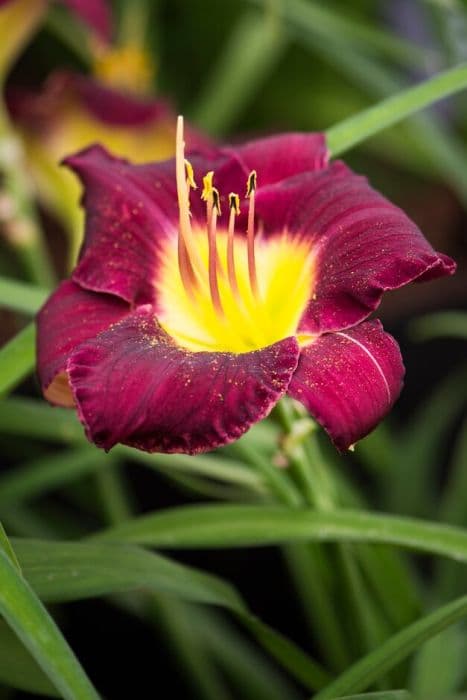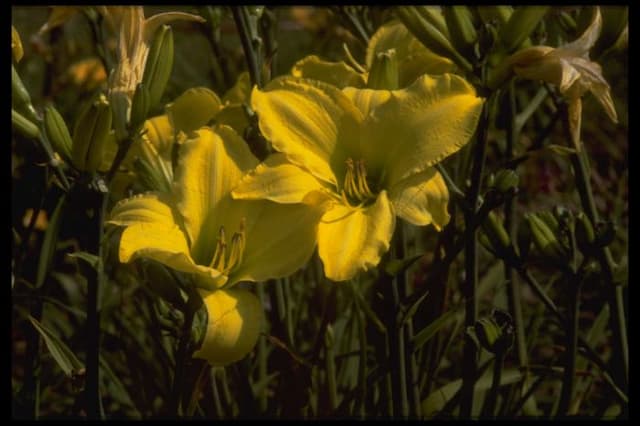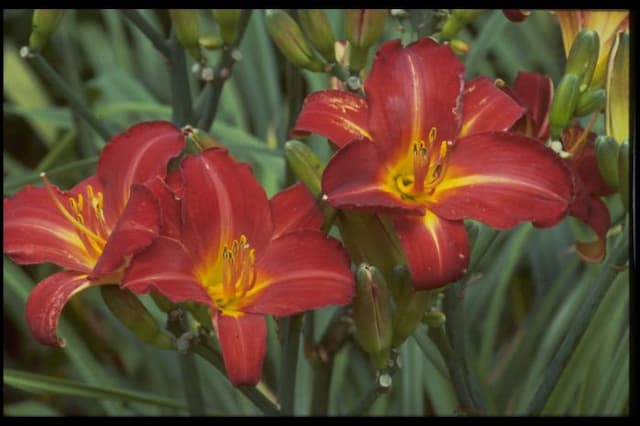Daylily Hemerocallis 'Missenden'

ABOUT
The Hemerocallis 'Missenden', commonly known as the Daylily 'Missenden', exhibits a striking appearance with its showy and vibrant flowers. The flowers bloom atop sturdy stems and each blossom persists for just a day, hence the name Daylily. The flowers themselves are large and often display a beautiful array of colors blending harmoniously. The petals are typically ruffled or have smooth, soft edges that give the plant a delicate, yet robust look. The leaves of the Daylily 'Missenden' are long and slender, forming a dense clump of foliage that is rich green in color. This foliage serves as a lush backdrop for the blooms, which rise above in eye-catching contrast. Throughout the blooming season, the plant produces numerous flower buds, ensuring a succession of flowers that enhance its ornamental value. Upon close inspection, the individual flowers reveal a striking throat, where the color is often accentuated or differs from the rest of the petals, drawing attention to the center of the bloom. The texture of the petals may have a subtle sheen or a velvety quality that catches the light and adds depth to the overall appearance of the flower. In general, the Daylily 'Missenden' is a hardy and reliable perennial, being less about the technicalities of size and more about its visual impact in the garden with its lush, strap-like foliage and the charming, transient beauty of its blooms.
About this plant
 Names
NamesFamily
Hemerocallidaceae
Synonyms
Daylily
Common names
Hemerocallis 'Missenden'.
 Toxicity
ToxicityTo humans
The daylily (Hemerocallis 'Missenden') is not considered toxic to humans, and in fact, some daylily flower parts are edible and consumed in various culinary traditions. However, it is essential to be certain of the identity of the daylily, as other similar-looking plants can be toxic. Consuming plants that are not explicitly identified for safe consumption is not recommended, as it can lead to mistaking toxic plants for edible ones.
To pets
Daylilies, including Hemerocallis 'Missenden,' are known to be extremely toxic to cats. Ingesting even a small amount of any part of the plant can cause severe kidney damage. Symptoms of daylily poisoning in cats include vomiting, lethargy, lack of appetite, increased urination followed by lack of urination, and kidney failure. If you suspect your cat has eaten any part of a daylily, immediate veterinary attention is necessary, as poisoning can be fatal. Daylilies are not typically dangerous to dogs; nevertheless, they might cause mild gastrointestinal upset if ingested.
 Characteristics
CharacteristicsLife cycle
Perennials
Foliage type
Deciduous
Color of leaves
Green
Flower color
Varies
Height
2 feet (60 cm)
Spread
2 feet (60 cm)
Plant type
Herb
Hardiness zones
3
Native area
Asia
Benefits
 General Benefits
General Benefits- Easy to grow: Hemerocallis, commonly known as daylily, is known for being low-maintenance and easy to cultivate in a variety of garden settings.
- Drought-tolerant: Once established, daylilies can tolerate periods of dry weather, making them suitable for xeriscaping or drought-prone areas.
- Pest-resistant: Daylilies are generally resistant to pests, reducing the need for chemical treatments in the garden.
- Attracts pollinators: The colorful flowers of Hemerocallis 'Missenden' attract bees, butterflies, and other beneficial pollinators to the garden.
- Long blooming period: Daylilies have a lengthy blooming season, providing flowers for an extended period in the summer.
- Variety of uses: They can be used in mixed borders, as groundcovers, or as mass plantings for a dramatic effect.
- Erosion control: The root system of daylilies helps to stabilize soil and prevent erosion on slopes and banks.
 Medical Properties
Medical PropertiesThis plant is not used for medical purposes.
 Air-purifying Qualities
Air-purifying QualitiesThis plant is not specifically known for air purifying qualities.
 Other Uses
Other Uses- Edible Blooms: The flowers of the daylily can be eaten raw or cooked, adding a sweet flavor and colorful garnish to salads and desserts.
- Natural Dye: The petals can be used to create a natural yellow-orange dye for textiles and crafts.
- Fish Poison: In some cultures, the roots have been used to stupefy fish, making them easier to catch, although this is not an environmentally friendly practice.
- Companion Planting: Daylilies can be used in companion planting to help deter certain pests that may otherwise affect nearby vegetables or fruits.
- Garden Themed Artwork: The striking blooms are often used as a subject in painting or photography due to their vibrant colors and appealing form.
- Floral Arrangements: Both the buds and open blooms can be used in floral arrangements, adding height and a splash of color to bouquets.
- Culinary Experiments: The mild, sweet flavor of the flowers makes them a unique ingredient for innovative chefs, including use in ice creams or sorbets.
- Education and Study: The daylily can be used as a specimen for educational purposes, teaching about plant biology and hybridization techniques.
- Water Conservation: Because daylilies are drought tolerant once established, they are ideal for xeriscaping, reducing the need for irrigation in gardens.
- Soil Erosion Control: The robust root system of daylilies helps to stabilize soil and prevent erosion on slopes or in areas with loose soil.
Interesting Facts
 Feng Shui
Feng ShuiThe Daylily is not used in Feng Shui practice.
 Zodiac Sign Compitability
Zodiac Sign CompitabilityThe Daylily is not used in astrology practice.
 Plant Symbolism
Plant Symbolism- Longevity: The common name for Hemerocallis 'Missenden' is Daylily, and the plant is known to symbolize longevity due to its ability to thrive and bloom year after year.
- Renewal and Motherhood: The Daylily's daily bloom cycle, where flowers last for just one day, is symbolic of renewal and the continuous cycle of life, motherhood and nurturing.
- Forgiveness: In some cultures, the Daylily is associated with forgiveness, as it returns each day with a fresh bloom, symbolizing a clean slate or forgiveness.
- Cherishing Each Moment: Because each flower of the Daylily lasts only a single day, it reminds one to value and cherish each moment.
 Water
WaterDaylilies, including the Hemerocallis 'Missenden', should be watered deeply once a week, providing about 1 inch of water which would be around 0.623 gallons per square foot. During hot or dry periods, watering frequency should increase to twice a week. It's best to water in the early morning to allow moisture to soak into the soil and reach the roots, while reducing evaporation. Avoid overhead watering to minimize the risk of leaf wetness and fungal diseases. Ensure that your daylily is planted in well-draining soil to prevent waterlogging.
 Light
LightDaylilies like Hemerocallis 'Missenden' thrive in full sun to partial shade. They should receive at least six hours of direct sunlight daily for optimum growth and bloom. If you live in a particularly hot climate, providing afternoon shade can help protect the plant from intense heat. Daylilies are adaptable but perform best with ample sunlight.
 Temperature
TemperatureDaylilies, including Hemerocallis 'Missenden', prefer moderate temperatures and can survive in zones 3 through 9. They can tolerate a temperature range from well below freezing to about 90°F. The ideal growing temperatures for daylilies are between 70°F and 85°F. They are quite resilient and can endure short periods of higher or lower temperatures.
 Pruning
PruningPrune daylilies like Hemerocallis 'Missenden' to remove spent flower stalks and enhance the appearance of the plant. After a flower has bloomed and begun to wilt, cut the stalk back to the base to encourage new growth and potential reblooms. Pruning should be done throughout the blooming season. Additionally, remove any dead or yellowing foliage to maintain plant health and appearance.
 Cleaning
CleaningAs needed
 Soil
SoilThe daylily 'Missenden' thrives in well-draining soil that is moderately fertile, with a preferred pH range of 6 to 6.5. A good soil mix for this plant can be made by blending equal parts of loamy garden soil, compost, and coarse sand to ensure good drainage and adequate nutrition.
 Repotting
RepottingDaylilies like 'Missenden' rarely need repotting as they are typically grown outdoors. However, if grown in containers, they should be repotted or divided every 3 to 4 years to rejuvenate their growth and prevent overcrowding.
 Humidity & Misting
Humidity & MistingThe daylily 'Missenden' is adaptable and tolerates a wide range of humidity levels outdoors. It prefers natural outdoor conditions and does not usually require specific humidity adjustments.
 Suitable locations
Suitable locationsIndoor
Place daylily 'Missenden' near bright window; water regularly.
Outdoor
Plant in sun/part-shade; water moderately; fertilize yearly.
Hardiness zone
3-9 USDA
 Life cycle
Life cycleHemerocallis 'Missenden', commonly known as the Daylily 'Missenden', begins its life cycle when seeds germinate in spring, usually after undergoing a period of cold stratification. The seedlings emerge and develop into young plants with strap-like foliage, focusing on root and foliage growth in the first year. As the plants mature, they form clumps that increase in size through vegetative propagation, producing offsets or divisions. Daylilies typically bloom in early to mid-summer, with each individual flower lasting only one day, hence the name Daylily. After flowering, the plant sets seed pods if pollination occurs, or the spent blooms are deadheaded to encourage reblooming or conserve plant energy. The plant enters a period of dormancy in the fall and overwinters as a root system before resuming growth the following spring.
 Propogation
PropogationPropogation time
Late summer to early fall
The Hemerocallis 'Missenden', commonly known as the Daylily, is best propagated through division, which is typically done in early spring or fall after flowering has finished. To propagate by division, the clump of the daylily should first be dug up, making sure to keep a generous amount of soil around the roots. The clump should then be separated into smaller sections, each with a good root system and at least one fan of leaves. These divisions can be replanted at the same depth they were originally growing at, spaced approximately 18 to 24 inches (45 to 60 centimeters) apart to allow sufficient room for growth. Water the newly planted divisions thoroughly to help establish them in their new location. This method of propagation helps to rejuvenate older clumps that may have become too crowded and also creates new plants that will usually bloom within the next growing season.









